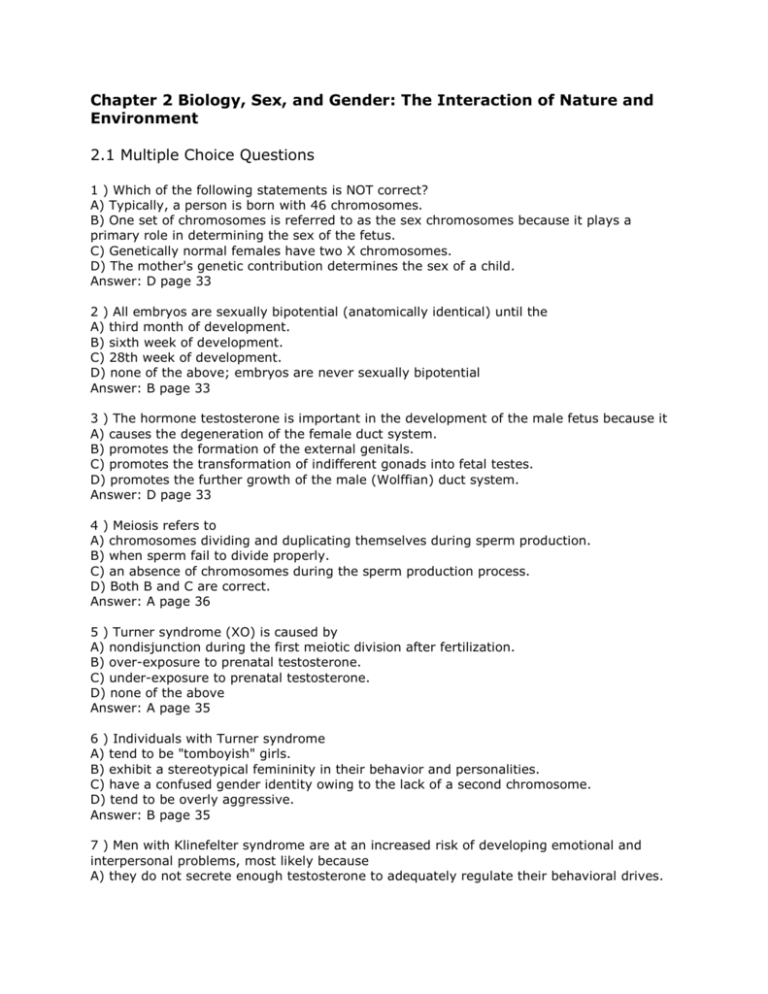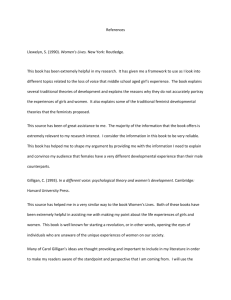Biology, Sex, & Gender Test Questions: Nature vs. Environment
advertisement

Chapter 2 Biology, Sex, and Gender: The Interaction of Nature and Environment 2.1 Multiple Choice Questions 1 ) Which of the following statements is NOT correct? A) Typically, a person is born with 46 chromosomes. B) One set of chromosomes is referred to as the sex chromosomes because it plays a primary role in determining the sex of the fetus. C) Genetically normal females have two X chromosomes. D) The mother's genetic contribution determines the sex of a child. Answer: D page 33 2 ) All embryos are sexually bipotential (anatomically identical) until the A) third month of development. B) sixth week of development. C) 28th week of development. D) none of the above; embryos are never sexually bipotential Answer: B page 33 3 ) The hormone testosterone is important in the development of the male fetus because it A) causes the degeneration of the female duct system. B) promotes the formation of the external genitals. C) promotes the transformation of indifferent gonads into fetal testes. D) promotes the further growth of the male (Wolffian) duct system. Answer: D page 33 4 ) Meiosis refers to A) chromosomes dividing and duplicating themselves during sperm production. B) when sperm fail to divide properly. C) an absence of chromosomes during the sperm production process. D) Both B and C are correct. Answer: A page 36 5 ) Turner syndrome (XO) is caused by A) nondisjunction during the first meiotic division after fertilization. B) over-exposure to prenatal testosterone. C) under-exposure to prenatal testosterone. D) none of the above Answer: A page 35 6 ) Individuals with Turner syndrome A) tend to be "tomboyish" girls. B) exhibit a stereotypical femininity in their behavior and personalities. C) have a confused gender identity owing to the lack of a second chromosome. D) tend to be overly aggressive. Answer: B page 35 7 ) Men with Klinefelter syndrome are at an increased risk of developing emotional and interpersonal problems, most likely because A) they do not secrete enough testosterone to adequately regulate their behavioral drives. B) the possession of an extra sex chromosome directly produces abnormal behavior in males. C) of the difficulties involved in trying to cope with the physical abnormalities associated with this chromosomal abnormality. D) they do not produce sperm. Answer: C page 37 8 ) The overrepresentation of XYY men among the institutionalized and incarcerated can best be explained by A) elevated testosterone levels which produce aggressive behavior. B) the disproportionate number of violent acts they commit. C) the way the criminal justice system reacts to their physical appearance. D) Both A and B are correct. Answer: C page 35 9 ) Adrenogenital syndrome (AGS) occurs in approximately 1 in _____ births. A) 5 B) 50 C) 500 D) 5,000 Answer: D page 38 10 ) Which of the following suffer from Adrenogenital syndrome (AGS)? A) individuals who possess the sex chromosomes of normal males (XY) but are born with the external genitalia of females B) individuals who have only one sex chromosome, an X C) individuals in whom sexual differentiation is incomplete D) individuals who have the internal reproduction organs of females but whose external genitals are masculinized Answer: D page 38 11 ) Studies of AGS girls indicate that they A) are significantly more aggressive than non-AGS girls. B) appear to be more "tomboyish" than non-AGS girls. C) show less interest in motherhood and marriage than non-AGS girls. D) express a greater interest in dolls and dresses than non-AGS girls. Answer: B page 38 12 ) Individuals who have the condition called androgen-insensitivity syndrome A) are sometimes referred to as XY females. B) are typically raised as females. C) express a lesser interest in dolls, motherhood, and dresses than genetically normal females. D) both A and B Answer: D page 38 13 ) Androgen-insensitive individuals A) often do not have their condition discovered until puberty. B) are as feminine as normal XX females. C) often have lower intelligence than normal XX females. D) all of the above E) Only A and B are correct. Answer: E page 38 14 ) Individuals with 5-alpha-reductase deficiency A) typically are reared as boys, even though externally they appear to be girls. B) have little difficulty changing their sex and gender identities at puberty when their external genitalia change. C) usually are recognized as "different" at birth and are socialized differently then "normal" boys. D) behave masculinity throughout childhood because of exposure to prenatal testosterone. Answer: C page 39 15 ) The specialization of the right and left hemispheres of the brain for different tasks is brain A) organization. B) dualism. C) lateralization. D) meiosis. Answer: C page 41 16 ) Studies of genital ambiguity A) are suspect because they must rely on data from very small, atypical samples. B) suggest that one's gender identity develops independently of one's chromosomal makeup. C) are subject to researcher biases. D) all of the above Answer: D page 40 17 ) Given the research on genital ambiguity, the authors of your text conclude that A) sex is dichotomous, gender is not. B) gender is dichotomous, sex is not. C) neither sex nor gender is dichotomous. D) more research needs to be done before any conclusions are drawn. Answer: C page 41 18 ) The E-S (empathizing-systemizing) theory states the following: A) Males are stronger at empathizing than females. B) Males are under-perform females in spatial tasks. C) Males are stronger at systemizing and females are stronger in emotion recognition, social sensitivity, and verbal fluency. D) Males and females have identical sex differences and brain organization. Answer: D (page 44) 19 ) Research on the human brain has revealed that A) men tend to depend on one hemisphere of the brain to complete certain tasks. B) women tend to draw on both hemispheres of the brain. C) women tend to depend on one hemisphere of the brain to complete certain tasks. D) Both A and B are correct. Answer: D page 43 20) Imperato-McGinley’s controversial explanation of eighteen Dominican DHT-deficient males concluded that: a) they easily switched their identities when their genitalia masculinized. b) at puberty, they became men. c) the easy transition was a result of having been exposed to prenatal testosterone. d) they were able to reject their time socialized as females. e) all of the above Answer: C page 40 21 ) Your text discusses a case studied by Money involving a set of identical twins who were genetically and physically normal males at birth. However, one of the twins had his penis accidentally cut off during surgery. The doctors recommended sex reassignment. At seventeen months old, the boy was surgically reconstructed as a girl and lifelong hormone replacement was begun. Research on this case revealed the twin who had undergone the sex reassignment A) was initially socialized successfully as a girl. B) preferred to wear dresses and play with traditional girl toys. C) began experiencing serious emotional problems in puberty and eventually refused to continue living as a girl. D) all of the above Answer: D page 46 22 ) A difficulty in looking for sex differences in the brain is that A) human brains remain the same as people age. B) scientists do not yet fully understand the way in which the structure of specific parts of the brain affect how they function. C) human brains are identical to the brains of animals. D) none of the above Answer: B page 42 23 ) Research about “His” and “Her” brains have revealed that A) male brains are larger than elephants and that is evidenced in their great intelligence. B) intelligence can accurately be measured by dividing body weight and brain size. C) brain organization may contribute to sex-specific behavior and sexual orientation. D) rats and other animals are accurate and reliable research subjects to use for studying human brains. Answer: C Page 41 24 ) Research on men’s and women's brains indicates that A) men have a larger corpus callosum. B) males are left-brain dominant; females are right-brain dominant. C) men's and women's brains are identical. D) males' and females' brains may develop or be structured differently. Answer: D page 41 25 ) Today, those interested in studying sex differences in the brain focus primarily on A) brain size. B) brain organization. C) IQ. D) None of the above; there are no known sex differences in the brain. Answer: B 26 ) Researchers have had difficulty ascertaining the relationship between testosterone and human aggression because A) testosterone levels fluctuate dramatically in response to environmental stimuli. B) neurotransmitters complicate matters by also affecting human behavior. C) only males produce testosterone and it therefore cannot explain female aggression. D) Both A and B are correct. Answer: D page 43 27 ) Which of the following is NOT true regarding human aggression? A) Studies show that women are never as aggressive as men, regardless of the situation. B) Women become more aggressive when they think no one is looking. C) Females are more likely than males to inhibit aggression when the chance of retaliation is high. D) For both males and females aggressiveness decreases as age and education increase. Answer: A page 45 28 ) Androgen comes from the Greek word for "man," while estrogen comes from the Greek word for "__________." A) woman B) frenzy C) prostitute D) illness Answer: B page 45 29 ) Some argue that much of the research on PMS is plagued by serious methodological difficulties, which include A) retrospective studies dependent on subjects' recall. B) selective memory of mood changes that happen during PMS. C) women perceiving researchers as condescending and therefore are reluctant to report information about PMS. D) all of the above Answer: D page 45 30 ) Research on the social-psychological causes of PMS indicates that A) negative expectations of and attitudes toward the experience of menstruation may precipitate a variety of physical and emotional symptoms. B) negative mood changes do not appear to be related in any significant way to stressful external events. C) debilitating symptoms associated with the menstrual cycle are psychosomatic. D) cyclical mood swings are exclusively a female experience. Answer: A page 48 31 ) Scientific studies of premenstrual syndrome (PMS) A) provide conclusive evidence that PMS is a gynecological disease. B) demonstrate that the job troubles of a majority of women are due to menstrual changes. C) indicate that PMS can be cured with regular injections of sex hormones. D) provide inconclusive evidence about the causes, consequences, and treatment of PMS. Answer: D page 49 32 ) Lynda Birke (as well as the authors of your text) supports the view that A) a person has a biological beginning which can later be culturally influenced. B) biological determinism provides the best explanation of gender development. C) social constructionism should replace biological determinism as the explanation of gender development. D) none of the above Answer: D page 52 2.2 True/False Questions 1 ) XYY syndrome has been associated with low intellectual functioning. Answer: TRUE page 35 2 ) Nondisjunction occurs when the chromosomes divide and duplicate themselves. Answer: FALSE page 35 3 ) Both males and females may have AGS. Answer: TRUE page 38 4 ) Most researchers report that AGS girls are significantly more physically aggressive than normal girls. Answer: FALSE page 38 5 ) Cross-cultural research reveals that how a society constructs gender identity is uniform throughout the world. Answer: FALSE page 41 6 ) Brain size determines intellectual ability. Answer: FALSE page 41 7 ) Individuals may be born with an abnormal complement of sex chromosomes due to chromosomal errors that occur during sperm production. Answer: TRUE page 36 8 ) Much of the evidence linking testosterone levels to aggression has come from animal studies. Answer: TRUE page 45 9 ) The hormone testosterone can fluctuate over the course of a day. Answer: TRUE page 46 10 ) Unlike research on hormones, much of the research on neurotransmitters has been done on humans. Answer: FALSE page 47 11 ) PMS is recognized in the American Psychiatric Association's diagnostic manual. Answer: TRUE page 49 12 ) Scientific research has proven that there is a direct relationship between brain lateralization and sex that predisposes males and females to behave differently. Answer: TRUE page 44 13 ) Some researchers have found that negative attitudes toward menstruation may influence women's experience of PMS symptoms. Answer: TRUE page 49 14 ) Research indicates PMS symptoms are really all "in the person's head." Answer: FALSE page 49 15 ) The authors of your text argue that biological explanations of gender differences are often used to justify gender inequality. Answer: TRUE page 52 16 ) Surgery to correct genital ambiguity is motivated by health and medical concerns. Answer: FALSE page 40 17 ) Neuropsychologists concede that there is considerable overlap in the male and female brain distributions and most differences are very small. Answer: TRUE page 45 2.3 Essay Questions 1 ) Discuss AGS, Turner syndrome, and androgen-insensitivity syndrome and what they teach us about gender. Answer: 2 ) Summarize this chapter's findings on sex differences in infants with regard to dependence and aggression. Answer: 3 ) What is brain lateralization (or hemispheric asymmetry) and what does it have to do with gender? Answer: 4 ) Should sex and gender be viewed dichotomously, according to the authors of your text? Explain your answer. Answer: 5 ) Explain the term premenstrual syndrome (PMS) and discuss how popular acceptance of this syndrome could both help and hinder the status of women. Answer: 6 ) Using your knowledge of sexual differentiation during fetal development, genital ambiguity, and brain lateralization, argue for or against this statement: Biological factors, not cultural ones, are responsible for specific gendered behaviors and sex differences. Answer: 7 ) What is meant by a "transformative account of gender development"? What is the potential for such a perspective to improve our understanding of the interaction of biology and culture in the formation of gender? Answer: 8) Explain the relationship between politics and the scientific explanation of sexuality. Answer: 9) Intersex individuals have been historically left out of the LGBT conversations. What recent contributions have intersexed individuals contributed to our perspectives on sexuality? Answer:








